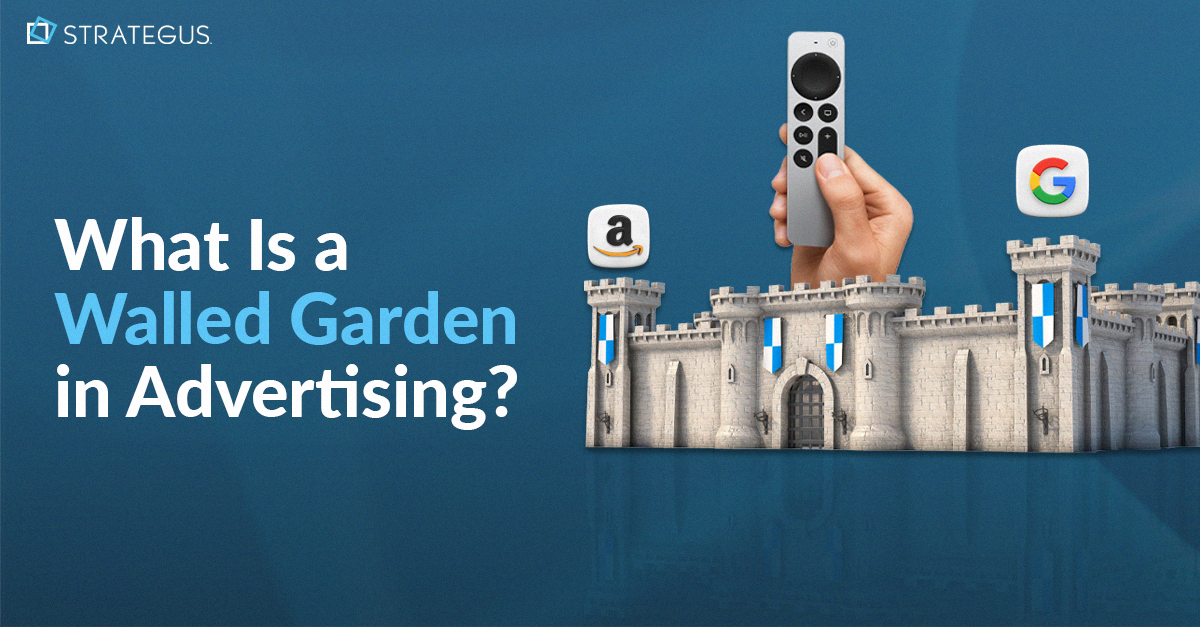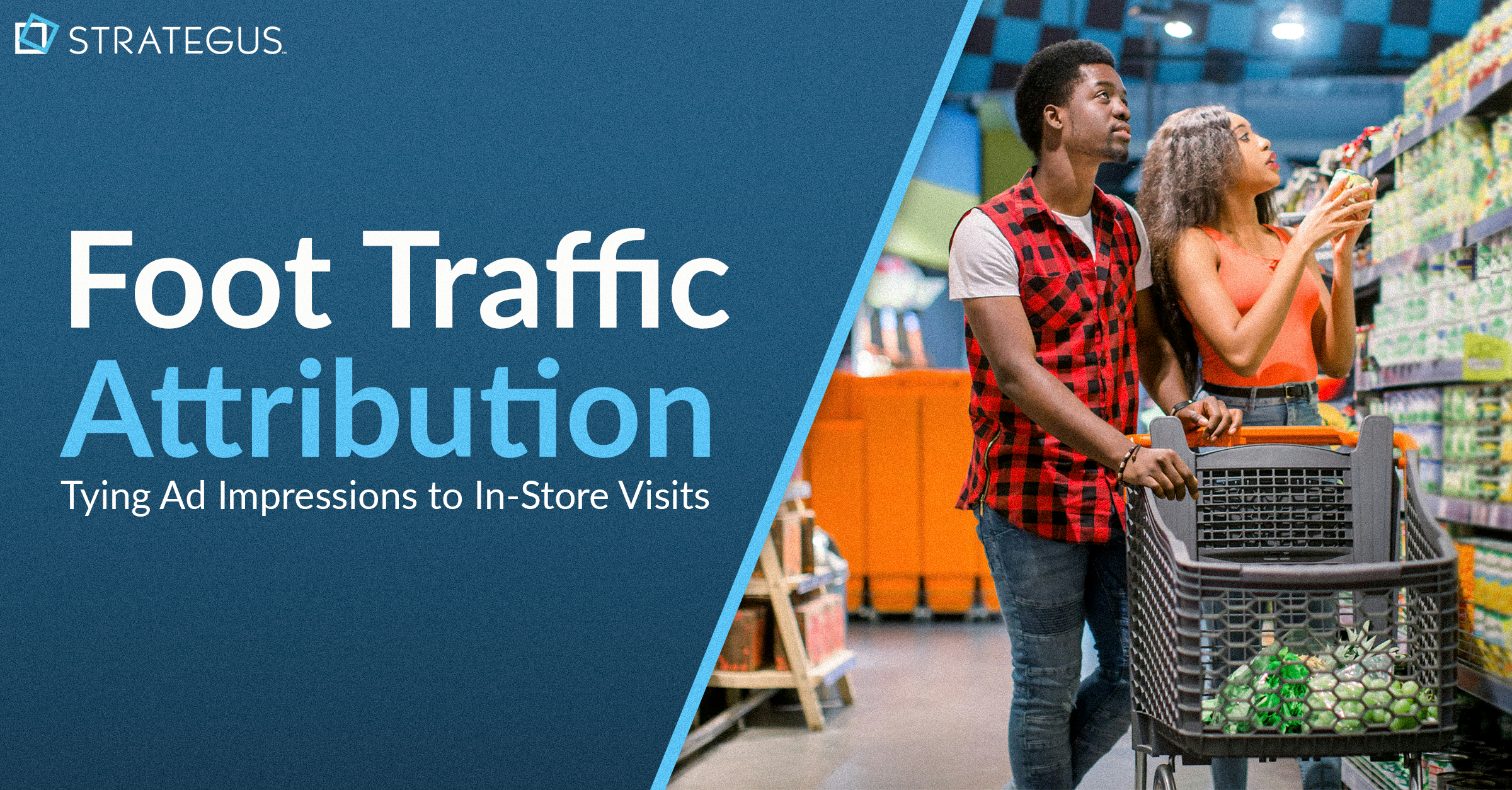- Home
- Strategus Blog
- What Is a Walled Garden in Advertising?
What Is a Walled Garden in Advertising?
 Traci Ruether
Traci Ruether
12 minutes read

Google has been under ongoing regulatory scrutiny for antitrust concerns — including an upcoming lawsuit by the Department of Justice (DOJ) that concerns Google’s ad tech dominance. Amazon, Apple, and Meta are also being investigated for their “walled garden” approach to advertising.
Across all these tech giants, the criticism is the same: Because these platforms control the content, data, and users, they stifle competition and limit consumer choice. This makes it difficult for advertisers (the consumers) to execute and measure efforts across multiple platforms.
So what is a walled garden and how can advertisers develop a strategy that overcomes these limitations? We break it all down in this article. In addition to looking at walled gardens in advertising at large, we zoom in on the connected TV (CTV) space, where lacking transparency into ad placement has long been a problem.
What Is a Walled Garden?
A walled garden is a closed ecosystem controlled by a single company that sets all the rules — from how its data and applications are accessed to how and when they’re paid. Most notably, walled gardens are designed to prevent their data from leaving in a format that’s interoperable with other ecosystems.
In the context of advertising, walled gardens refer to the platforms that are in charge of:
- What content users see
- Which companies can place ads
- Which user segments are served the ads
- What users do after seeing the ads (e.g., click, convert, etc.)
- How this goldmine of data is collected, shared, and re-monetized
Some of the most well-known examples of walled gardens in advertising include Google, Amazon, Meta, and Apple. These platforms have large active user bases and offer a varied approach to driving engagement and monetization — such as search, social media, and e-commerce — all within their own ecosystem.
A Look at Google’s Walled Garden
Let’s start with Google. As the world’s leading search engine (and more than 91% of the market share), Google powers global commerce, political discourse, entertainment, and our everyday lives. This makes the company’s influence large, but the Google empire doesn’t stop there.
Google’s primary source of revenue is ads that run within the search engine results page (SERP) and other owned properties like YouTube. Additionally, Google generates income from enterprise cloud computing services sold via Google Cloud, subscription-based streaming services on YouTube Premium and YouTube TV, hardware products like the Google Pixel and Google Home devices, and productivity and collaboration tools like Gmail, Google Calendar, and Google Drive.
Google's products and services are an integral part of our daily lives. As such, the tech behemoth has access to vast amounts of user data — ranging from smartphone GPS location tracking to search history. This data is monetized by Google’s ad-tech business, which places targeted ads across both Google-owned properties and the open web.
The problem with this for marketers is that Google also controls how ad performance is measured. As such, when someone searches for your brand in Google and then clicks on a paid ad, Google takes credit for the conversion using a methodology called ’last-click’ attribution.
Source: The Department of Justice
But the truth is, Google simply owns the platform that we’ve been trained to use when navigating the web. While countless other marketing efforts often contribute to branded searches — including brand awareness building with TV advertising, demand-gen efforts with search engine optimization, lead nurturing with retargeting tactics, the list goes on — Google takes 100% of the credit for providing a link to your website after these users have progressed through the funnel.
The Department of Justice explains:
“Google now controls the digital tool that nearly every major website publisher uses to sell ads on their websites (publisher ad server); it controls the dominant advertiser tool that helps millions of large and small advertisers buy ad inventory (advertiser ad network); and it controls the largest advertising exchange (ad exchange), a technology that runs real-time auctions to match buyers and sellers of online advertising.”
This makes it difficult for alternative search engines to compete with Google, while also forcing advertisers to adopt Google’s tools due to its vast market share.
A Look at Amazon’s Walled Garden
Another example is Amazon. The company already dominates retail e-commerce, cloud computing, organic grocery, content production, and streaming television. But that’s not all.
Amazon took the unprecedented move of shifting all Prime Video households to ad-supported by default earlier this year, thereby becoming one of the biggest players in CTV advertising overnight. Amazon is now the largest CTV platform in terms of its ad-supported audience size.
These details alone don’t make Amazon a walled garden, though. Rather, the retailer’s ownership over its entire ad tech stack is what seals the deal. Beyond just operating biggest e-commerce marketplace on the planet, Amazon quietly built its demand-side platform (DSP) to monetize this growing library of content (and the hundreds of millions of people who use Amazon apps, sites, and products daily).
Take it from our Co-Founder and EVP of Innovation, Joel Cox:
How Do Walled Gardens Work?
Walled gardens are self-contained environments that by intent and definition, either prevent users and data from leaving, or provide data in an inoperable fashion. This makes marketers beholden to a single inventory source, compromising their ability to holistically measure and engage target audiences across apps.So why are walled gardens so prolific despite the cons that come with them? It often comes down to their dominance and a few key benefits.
Ease of Use and Simplicity
Google’s search engine indexes the internet’s unending complexity in its entirety. Then there’s Meta, a social media ecosystem that spans Facebook, Instagram, WhatsApp, and Threads. And don’t forget about Amazon, the world’s largest online retailer.
The playbook of these walled gardens is to build a robust platform where people want to be and then monetize the user base as a one-stop-shop for advertisers. In this way, walled gardens make it easy for anyone with a credit card and 30 minutes to run significant ad campaigns.
What’s more, advertising with a single or even a few walled garden(s) is often simpler than executing cross-platform ad campaigns. This forces marketers to tie their strategy to specific publishers or channels rather than taking an audience-centric approach that follows buyers across touchpoints.
Audience Segmentation
Another advantage that walled gardens offer advertisers is the ability to segment audiences based on user data collected within the ecosystem. This data can include demographics, interests, behaviors, past purchases, search intent, and more — allowing for ultra-targeted and personalized advertising.
Meta, for example, collects user data through its social media platforms and then allows advertisers to target people based on the pages they like, their political affiliations, and major life events. This level of audience segmentation is not always possible on open platforms, where user data isn’t as readily available.
Brand Visibility
Walled gardens also offer unprecedented brand visibility due to their large user bases. As such, companies that advertise on these platforms are better positioned to build brand awareness than their competitors that choose not to.
Going back to Google, a recent study conducted by SparkToro found that more than 63% of all web traffic originates from the search engine. Another 3.5% comes from the Google-owned YouTube. This means that by advertising on Google-owned properties, advertisers gain access to the lion's share of internet referral traffic.
This is exactly why well-known companies often pay Google to rank for their own branded keywords. Even though most users typing a company name into the search engine are already looking for that company’s website, Google acts as a gatekeeper and collects a toll along the way.
The Problem With Walled Gardens in Advertising
Digital advertising runs on data. And getting it right requires free and open access to this data. Unfortunately, walled gardens create barriers around this data and force advertisers to take a platform-centric approach to advertising.
Limited Reach
One of the main limitations of walled gardens is their reach. Because these platforms make advertisers dependent on specific ecosystems, they make it difficult to follow users across different publishers and channels.
This means that advertisers miss out on reaching potential customers who aren’t part of the walled garden’s user base. This can be especially problematic for smaller businesses or those with niche target audiences.
Lack of Transparency
Another issue with walled gardens is the lack of transparency they offer. Because platforms like Amazon Prime control the data within their ecosystem, advertisers don’t always have access to the same level of insights as they would using an open platform. Multi-publisher control also becomes a challenge.
Say a university wanted to run targeted connected TV (CTV) ads to drive prospective students to their site. Sticking with a single streaming platform like YouTube TV would only allow them to reach a handful of potential buyers. An alternative tactic would be to pick a few different CTV channels and execute them as separate campaigns. But then challenges arise in capping ad frequency and tracking the holistic journey across disparate touchpoints.
At Strategus, we overcome this by curating as many inventory sources as possible and measuring ad performance across all of them holistically. That way, no matter where our customers’ target audience goes, we’re able to reach them and optimize the user experience.
Vendor Lock-In
Last but not least, walled gardens create major dependency issues. Because these platforms control both the content and the advertising within their ecosystem, they can change their policies and guidelines at any time, potentially impacting the effectiveness of ads. What’s more, if a platform experiences a significant decline in users or popularity, it can have a major impact on the success of advertising efforts.
Consider the Hollywood strikes last year. As platforms like Prime and Disney+ put a halt on releasing new content, Americans viewing habits changed overnight. But that doesn’t mean people watched less television — they just found something else to watch (and often somewhere else to watch it). Perhaps that meant swapping new episodes of Euphoria on HBO for reruns of The Office on Peacock. Many viewers also checked out free channels like Tubi for the first time, resulting in major growth across free ad-supported streaming TV (FAST).
Regardless of where viewers went, the result was the same. Viewers moved away from particular apps when the original content dropped off and found something new.
And any advertisers relying solely on walled gardens like Netflix or Prime Video for their CTV advertising efforts were heavily impacted in the process. Why? Because their campaigns relied on specific streaming ecosystems, it wasn’t easy to adapt and advertise elsewhere.
This highlights a major challenge in the CTV space: given that churn has become a constant, vendor lock-in should be avoided at all costs.
How to Navigate Walled Gardens in Advertising
The best way to overcome walled gardens is to take an audience-centric approach that utilizes a mix of walled gardens and open platforms. This allows marketers to reach a wider audience and reduce the impact of changes within a single ecosystem.
But this is easier said than done.
Taking a diversified approach to CTV advertising requires:
- Industry expertise
- A seat on several DSPs
- Access to a multitude of data providers
- Integrations with myriad publishers and their SSPs
- A dedicated team running campaign execution and monitoring
This is where Strategus comes into play. As the first and only pure-play CTV managed service partner, we provide the know-how and technology required to get the most out of your investment.
We support agencies and brands with:
- Direct integration with 400+ CTV inventory and data partners.
- Custom CTV targeting that layers first- and third-party insight.
- Industry-leading attribution tools that provide insight into the entire buyer’s journey.
- Cross-device retargeting capabilities that re-engage viewers across the programmatic ecosystem.
- Personalized guidance and hands-on execution every step of the way.
Conclusion
Despite growing regulation and an industry-wide commitment to a more open internet, walled gardens continue to put up obstacles. So will 2024 be the year that big tech companies break down their walls, or are new ones on the horizon?
Unfortunately, Strategus Co-Founder and EVP Joel Cox predicts the latter:
“This time next year, we're all going to be grappling with how we integrate an Apple DSP that is fundamentally iOS and Apple TV content-centric into our marketing plan. It'll be the walled garden of all walled gardens — the most desirable cohort in the United States.
They've signaled as much. They're already dabbling into an ad market... I can't see a time when Apple doesn't set their eyes on connected television monetization from a DSP standpoint and absolutely rock the industry.”
This is why it’s more important than ever to operate from a tech- and data-agnostic standpoint. As long as you’re tied to an individual programmatic platform, you’ll be limited in your ability to deliver integrated ad campaigns that can be easily measured and optimized.
At Strategus, we team up with brands and agencies to simplify CTV advertising and drive better performance. Our partner ecosystem integrates countless ad exchanges, SSPs, DSPs, publishers, and data providers to ensure precision targeting at scale.
The CTV industry is also dynamic, which is why we’re constantly vetting new partners and testing new technology. Our vendor-agnostic approach delivers flexibility in how we approach each campaign and the agility required to stay on the cutting edge.
Contact us today to learn more.

Traci Ruether is a content marketing consultant specializing in video tech. With over a decade of experience leading content strategy, she takes a metrics-driven approach to storytelling that drives traffic to her clients' websites. Follow her on LinkedIn at linkedin.com/in/traci-ruether or learn more at traciruether.com.
Strategus is a managed services connected TV(CTV) advertising agency with over 60,000+ campaigns delivered. Find out how our experts can extend your team and drive the result that matter most.
Talk to an Expert
Table of Contents
Seeking a Custom CTV Strategy That Delivers?
What to read next

Third-Party Data Targeting for CTV: Benefits & Tactics
Third-party data. It’s a term that’s thrown around, and yet few take the time to detail its pros and cons — much less strategies for using...
7 minutes read

First-Party Data Targeting: Benefits and Tactics for CTV Advertising
First-party data is the information that companies collect directly from their customers rather than through intermediaries. Advertisers use this...
10 minutes read

Foot-Traffic Attribution: Tying Ad Impressions to In-Store Visits
The marketing funnel has changed. Today’s shoppers often begin researching products from the comfort of their homes and don’t set foot into a store...
8 minutes read

CTV Attribution: What It Is and How It Works
Connected TV (CTV) viewing is on the rise — and that’s good news for marketers. Not only can CTV ads be precisely targeted to individual households,...
9 minutes read

















